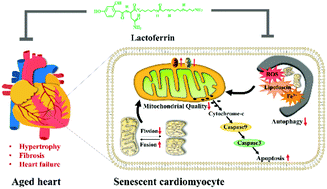Lactoferrin ameliorates pathological cardiac hypertrophy related to mitochondrial quality control in aged mice†
Abstract
Pathological myocardial hypertrophy, which lacks effective prevention and treatment strategies, makes the elderly susceptible to various cardiovascular diseases. Based on the beneficial attributes of lactoferrin in aging-related diseases, we aimed to investigate whether lactoferrin could exert protection against aging-related cardiac hypertrophy and further explore the underlying mechanisms. Here, we assessed the effects of lactoferrin on myocardial pathology, apoptotic proteins, mitochondrial morphology, kinetics, autophagy, and aging-related markers, including lipofuscin deposition, overloaded iron, and oxidative stress, which are known to destabilize the mitochondrial–lysosomal axis in aged mice. Upon the administration of lactoferrin, aged hearts showed amelioration of pathological cardiac hypertrophy, which was associated with decreased apoptosis, improved morphology, rearrangement of mitochondrial dynamics, increased lysosome-dependent autophagy, and inhibition of factors detrimental to the mitochondrial–lysosomal axis. In conclusion, lactoferrin ameliorated pathological cardiac hypertrophy, potentially by improving the mitochondrial quality related to mitochondrial dynamics and the mitochondrial–lysosomal axis, thus reducing mitochondria-dependent apoptosis, which is the pivotal factor for cardiac hypertrophy in aged mice.



 Please wait while we load your content...
Please wait while we load your content...